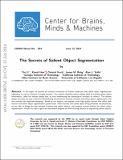| dc.contributor.author | Li, Yin | |
| dc.contributor.author | Hou, Xiaodi | |
| dc.contributor.author | Koch, Christof | |
| dc.contributor.author | Rehg, James M. | |
| dc.contributor.author | Yuille, Alan L. | |
| dc.date.accessioned | 2015-12-10T22:48:37Z | |
| dc.date.available | 2015-12-10T22:48:37Z | |
| dc.date.issued | 2014-06-13 | |
| dc.identifier.uri | http://hdl.handle.net/1721.1/100178 | |
| dc.description.abstract | In this paper we provide an extensive evaluation of fixation prediction and salient object segmentation algorithms as well as statistics of major datasets. Our analysis identifies serious design flaws of existing salient object benchmarks, called the dataset design bias, by over emphasising the stereotypical concepts of saliency. The dataset design bias does not only create the discomforting disconnection between xations and salient object segmentation, but also misleads the algorithm designing. Based on our analysis, we propose a new high quality dataset that offers both fixation and salient object segmentation ground-truth. With fixations and salient object being presented simultaneously, we are able to bridge the gap between fixations and salient objects, and propose a novel method for salient object segmentation. Finally, we report significant benchmark progress on three existing datasets of segmenting salient objects. | en_US |
| dc.description.sponsorship | The research was supported by the ONR via an award made through Johns Hopkins University, by the G. Harold and Leila Y. Mathers Charitable Foundation, by ONR N00014- 12-1-0883 and the Center for Minds, Brains and Machines (CBMM), funded by NSF STC award CCF-1231216. This research was also supported by NSF Expeidtion award 1029679, ARO MURI award 58144-NS-MUR, and Intel Science and Technology Center in Pervasive Computing. | en_US |
| dc.language.iso | en_US | en_US |
| dc.publisher | Center for Brains, Minds and Machines (CBMM), arXiv | en_US |
| dc.relation.ispartofseries | CBMM Memo Series;014 | |
| dc.rights | Attribution-NonCommercial 3.0 United States | * |
| dc.rights.uri | http://creativecommons.org/licenses/by-nc/3.0/us/ | * |
| dc.subject | Fixation Prediction | en_US |
| dc.subject | Machine Learning | en_US |
| dc.subject | Object Recognition | en_US |
| dc.title | The Secrets of Salient Object Segmentation | en_US |
| dc.type | Technical Report | en_US |
| dc.type | Working Paper | en_US |
| dc.type | Other | en_US |
| dc.identifier.citation | arXiv:1406.2807v2 | en_US |
